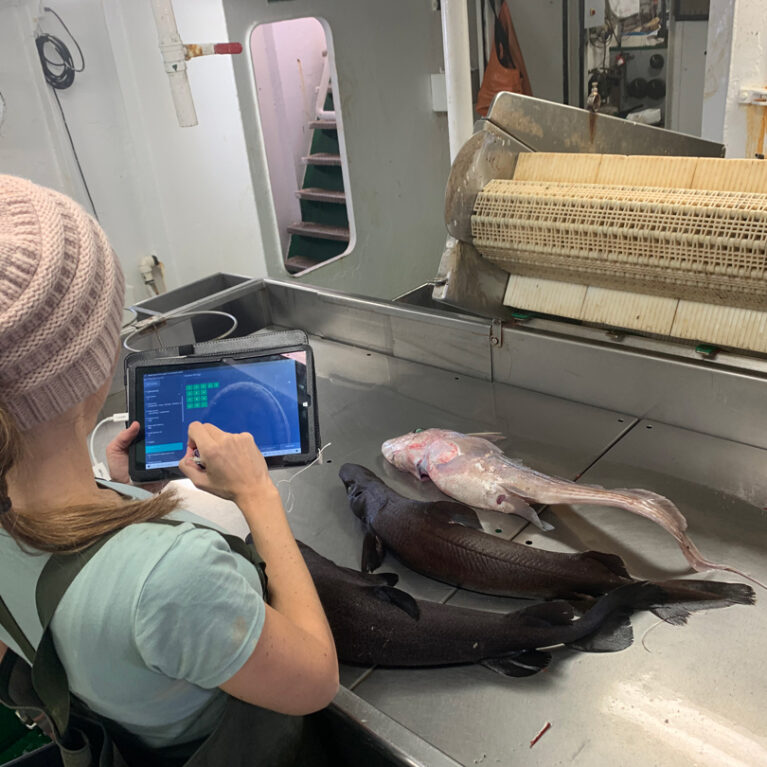Can deep-sea sharks survive – and thrive – in fishing grounds?
Sofia is driven by a passion for deep-sea sharks and aims to produce a fishing handling protocol for deep-sea fishermen in Portugal’s southern Mediterranean and Atlantic waters. She developed the DELASMOP project to assess the condition and survival of elasmobranchs caught in fisheries in the north-east Atlantic. Sofia collects vital information about the fishing vessels while aboard deep-sea crustacean trawlers, and also samples the sharks brought in as bycatch. She tags them before release to gauge their survival rates, and collects tissue samples to understand their diet and assess if there’s overlap between shark feeding grounds and fishing areas.
I grew up in Rio de Janeiro, one of the most dangerous cities in the world, but the sea was where I always felt safe. As a child I used to watch Jacques Cousteau documentaries with my grandmother and I remember being very drawn to the ocean, but I had no concept that it could provide a career for a city girl. It was only when I was in my late teens, with no idea of which career path I wanted to follow, that something ‘clicked’ while I was watching a documentary, and I ended up chasing my childhood dreams...
DELASMOP: is it possible for deep-sea sharks and rays thrive and survive in fishing grounds?
DELASMOP aims to contribute to the conservation of deep-sea elasmobranchs by developing a guide to the best fishing techniques and handling practices aboard fishing vessels to decrease the number of deep-sea elasmobranchs caught in crustacean bottom-trawl fisheries, while increasing their chances of survival after release.
Portugal is the leading consumer of seafood in Europe (57 kilograms, or 125 pounds, per person per year), and the south and south-west coasts are the most important areas for crustacean bottom-trawlers. Unfortunately, the estimated deep-sea elasmobranch by-catch in these fisheries is 40%. Although current European legislation requires the mandatory realease of most deep-sea elasmobranchs, it is unclear whether they survive after being released. This is of great concern, since 44% of deep-sea elasmobranchs in Europe are endangered or basic ecological and biological information about them is lacking.
The targeted fishing of deep-sea elasmobranchs (sharks and skates) is prohibited in Europe, but many are still caught incidentally and discarded, especially in the crustacean bottom-trawler fishery. In Portugal, up to 80% of this fishery’s catch is incidental and deep-sea elasmobranchs represent 40%. This is of great concern because these elasmobranchs are extremely vulnerable due to increased pressure and their slower growth rates resulting from the lower temperatures at depth. This means that deep-sea species are overfished more quickly than their shallow-water counterparts because their populations cannot rebound. In addition, overexploitation may have profound consequences for some species not only locally but also globally, because some deep-sea elasmobranchs are migratory. Estimating their immediate mortality rates and post-release mortality is important because it leads to establishing sound management measures. However, this type of information is costly, technically difficult to obtain and varies significantly depending on the fishery, habitat, season, type of gear, etc. Available estimates are therefore disparate and limited to a few species and fisheries. For instance, for longline fisheries the immediate mortality rates for deep-sea sharks and skates can vary from 0% to 100% and the post-release mortality can be as high as 83%. Data on the overlap of elasmobranchs and fisheries are also scarce and difficult to obtain. In a recent study of pelagic sharks, it was demonstrated that there is an 80% overlap between shark habitats and fishing areas, since sharks select and aggregate in areas with high productivity, which are also targeted by longliners. It is likely that an overlap would also occur between deep-sea elasmobranch habitat and crustacean bottom-trawl fisheries, as the elasmobranchs will occupy habitats where food is readily available and the fisheries operate at increasing depths to maximise catches for revenue.
- To identify the most common deep-sea sharks and skates taken as by-catch by crustacean bottom-trawl fisheries and correlate this information with environmental data and operational fishing procedures. We will collect information during routine commercial fishing activities and then, in combination with findings from research at sea, we will identify the procedures that result in lower catches of deep-sea elasmobranchs.
- To evaluate the effect of crustacean bottom-trawl fisheries on the survival of deep-sea elasmobranchs. Immediate survival rates will be determined on board. Long-term survival rates will be estimated by tagging and releasing live individuals with a system of numbered dart tags.
- To evaluate the probability of each deep-sea shark or skate species being caught by a bottom-trawler by identifying their preferred prey, using non-lethal methods. We believe that if crustaceans are an important component of their diet, there is an increased risk that they will be caught by the bottom-trawlers.
- To prepare a protocol with fishing techniques and handling practices adapted to decrease the number of deep-sea elasmobranchs caught, while increasing their chances of survival after release.
- To organise and conduct meetings with fishermen, fishing associations and governmental institutions to identify the main challenges and to disseminate the project’s findings on deep-sea elasmobranch-friendly procedures. Also, to distribute the main findings for the general public through the website and social media and at events in environmental awareness centres.
Public presentation at MODS: Save Our Seas Distinguished Speaker Series : Deep Sea Sharks Panel Discussion


